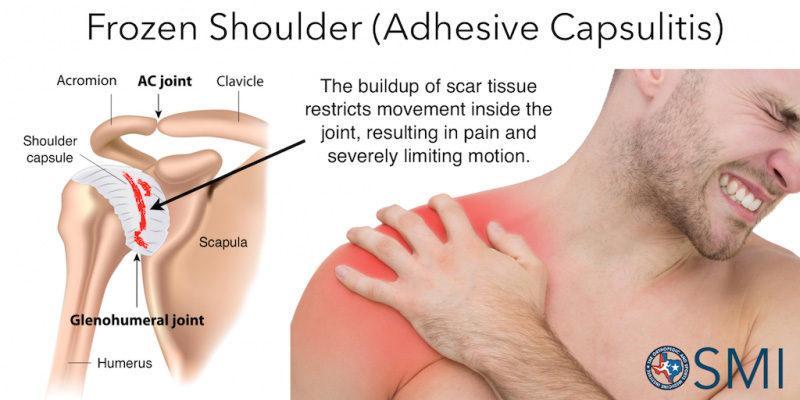
3 Stages of Frozen Shoulder

Ever heard of the 3 Stages of Frozen Shoulder? If you haven’t heard of it, it is exactly as the name suggests – your shoulder becomes “frozen” due to pain and stiffness. The condition, medically known as adhesive capsulitis, occurs in roughly 2% of the general population and usually in women between the ages of 40 and 60.
In a normal shoulder, the upper arm, shoulder blade, and collarbone come together with the help of tendons and muscles called the shoulder capsule. Synovial fluid lubricates the capsule and the joints for easier movement.
In someone with frozen shoulder, though, the capsule thickens and becomes tight. Stiff tissues called adhesions develop, and generally, there is less synovial fluid. All of this combines to prevent movement in your shoulder with or without help.
With Frozen Shoulder, there are typically three stages:
- Freezing Stage: Shoulder becomes increasingly painful, and you slowly lose range of motion. This usually occurs over 6 to 9 weeks.
- Frozen Stage: This stage immediately follows the freezing stage and is usually less painful though the stiffness remains. This usually lasts roughly 4 to 6 months making daily activities very difficult.
- Thawing Stage: This stage is where the shoulder slowly improves with either a complete return to normal or close to normal strength and motion. This usually takes anywhere from 6 months to 2 years to happen.
Unfortunately, there isn’t any clear cause or reason for Frozen Shoulder and it is minimally understood. It is thought that those with diabetes, certain medical diseases like thyroidism (hyper and hypothyroidism) and other diseases could put someone at a greater risk for the condition. Also, if one has a shoulder that has been immobilized due to injury, they may also be a t greater risk.
If you experience any of the symptoms described, doctors will likely perform a physical examination to test your active range of motion. They will also perform imaging tests like x-rays, MRIs, and ultrasounds to rule out other conditions or issues.
Some doctors will likely put you on anti-inflammatories or steroid injections in combination with physical therapy to reduce the pain and help to restore motion.
3 Stages of Frozen Shoulder exercises – If you do have the condition or regularly have issues with your shoulders, there are a few stretches that you can do:
- External rotation — passive stretch.

Reproduced with permission from JF Sarwark, ed: Essentials of Musculoskeletal Care, ed 4. Rosemont, IL, American Academy of Orthopaedic Surgeons, 2010.
Stand in a doorway and bend your affected arm 90 degrees to reach the doorjamb. Keep your hand in place and rotate your body as shown in the illustration. Hold for 30 seconds. Relax and repeat.
- Forward flexion — supine position.

Reproduced with permission from JF Sarwark, ed: Essentials of Musculoskeletal Care, ed 4. Rosemont, IL, American Academy of Orthopaedic Surgeons, 2010.
Lie on your back with your legs straight. Use your unaffected arm to lift your affected arm overhead until you feel a gentle stretch. Hold for 15 seconds and slowly lower to start position. Relax and repeat.
- Crossover arm stretch.

Reproduced with permission from JF Sarwark, ed: Essentials of Musculoskeletal Care, ed 4. Rosemont, IL, American Academy of Orthopaedic Surgeons, 2010.
Gently pull one arm across your chest just below your chin as far as possible without causing pain. Hold for 30 seconds. Relax and repeat.
This article is brought to you by Dr. Brandon Downs. Dr. Downs can help you understand your elbow pain. Find Dr.Downs at:
Orthopaedic Specialists, 1912 Charlotte Avenue, Nashville, Tn 37203 (615) 590-8000
and
Orthopaedic Specialists, 415 Henslee Drive in the Creekside Center, Dickson, Tn 37055
(615) 375-8287, Orthopaedicspecialists.com
You Might Also Enjoy...


3 Ways PRP Therapy Accelerates Healing

5 Benefits of Robotic-Assisted Joint Replacement

How Does Bone Marrow Therapy Work For Osteoarthritis?

5 Easy Tips for Navigating the Holidays After Orthopaedic Surgery

